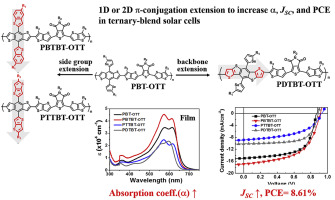Organic Electronics ( IF 2.7 ) Pub Date : 2020-04-02 , DOI: 10.1016/j.orgel.2020.105738 Hyeongjin Hwang , Chaneui Park , Dong Hun Sin , Eunjoo Song , Kilwon Cho

|
The effects of one-dimensional (1D) and two-dimensional (2D) π-conjugation extensions of donor–acceptor (D–A) copolymers on their intrinsic and photovoltaic properties in ternary-blend organic solar cells (OSCs) were investigated systematically by using one polymer donor and two acceptors (PC71BM, ITIC). A series of wide bandgap D–A copolymers (PBT-OTTs) were synthesized based on the benzo[1,2-b:4,5-b′]dithiophene (BDT) unit and the thieno[3,4-c]pyrrole-4,6(5H)-dione (TPD) unit, which extend in the backbone (1D) and side-group directions (2D) respectively from the PBT-OTT backbone. These copolymers are PBT-OTT (the parent polymer), PDTBT-OTT (with a 1D backbone extension consisting of dithieno[2,3-d; 2′,3′-d′]benzo[1,2-b; 4,5-b′]dithiophene), PTTBT-OTT (with a 2D side group extension consisting of 2-alkyl thieno[3,2-b]thiophene (TT)), and PBTBT-OTT (with a 2D side group extension consisting of 2-alkyl benzo[b]thiophene (BT)). Light absorption is significantly increased in the case of PBTBT-OTT due to its extended 2D π-conjugation length and high crystallinity. This increase results from the extended delocalization length and the increased absorption coefficient α of PBTBT-OTT. The wide bandgap polymer PBTBT-OTT has the highest α of the series, so the complementary absorption of the low bandgap ITIC means that the ternary-blend OSCs based on PBTBT-OTT exhibit the highest JSC = 16.61 mA cm−2 and PCE = 8.61%. We believe that these findings provide systematic guidelines for the π-conjugation extension of conjugated polymers and thus the design of high-efficiency ternary-blend OSCs.
中文翻译:

用于三元混合太阳能电池的高吸收系数π共轭扩展的供体-受体共聚物
通过三元体系有机太阳能电池(OSC)系统研究了供体-受体(DA)共聚物的一维(1D)和二维(2D)π共轭扩展对其内在和光伏特性的影响。使用一个聚合物供体和两个受体(PC71BM,ITIC)。基于苯并[1,2-b:4,5-b']二噻吩(BDT)单元和噻吩并[3,4-c]吡咯,合成了一系列宽带隙DA共聚物(PBT-OTTs) -4,6(5H)-二酮(TPD)单元,分别从PBT-OTT骨架在骨架(1D)和侧基方向(2D)上延伸。这些共聚物是PBT-OTT(母体聚合物),PDTBT-OTT(一维骨架扩展由二噻吩并[2,3-d; 2',3'-d']苯并[1,2-b; 4, 5-b']二噻吩),PTTBT-OTT(具有由2-烷基噻吩并[3,2-b]噻吩(TT)组成的2D侧基扩展)和PBTBT-OTT(具有由2-烷基苯并[b]噻吩(BT)构成的2D侧基扩展)。在PBTBT-OTT的情况下,由于其2Dπ共轭长度延长和高结晶度,光吸收显着增加。这种增加从扩展离域长度结果和增加的吸收系数α的PBTBT-OTT。宽带隙聚合物PBTBT-OTT具有该系列中最高的α,因此低带隙ITIC的互补吸收意味着基于PBTBT-OTT的三元混合OSC表现出最高的J SC = 16.61 mA cm-2和PCE = 8.61%。我们相信这些发现为共轭聚合物的π-共轭延伸提供了系统的指导,从而为高效三元共混物OSC的设计提供了指导。











































 京公网安备 11010802027423号
京公网安备 11010802027423号